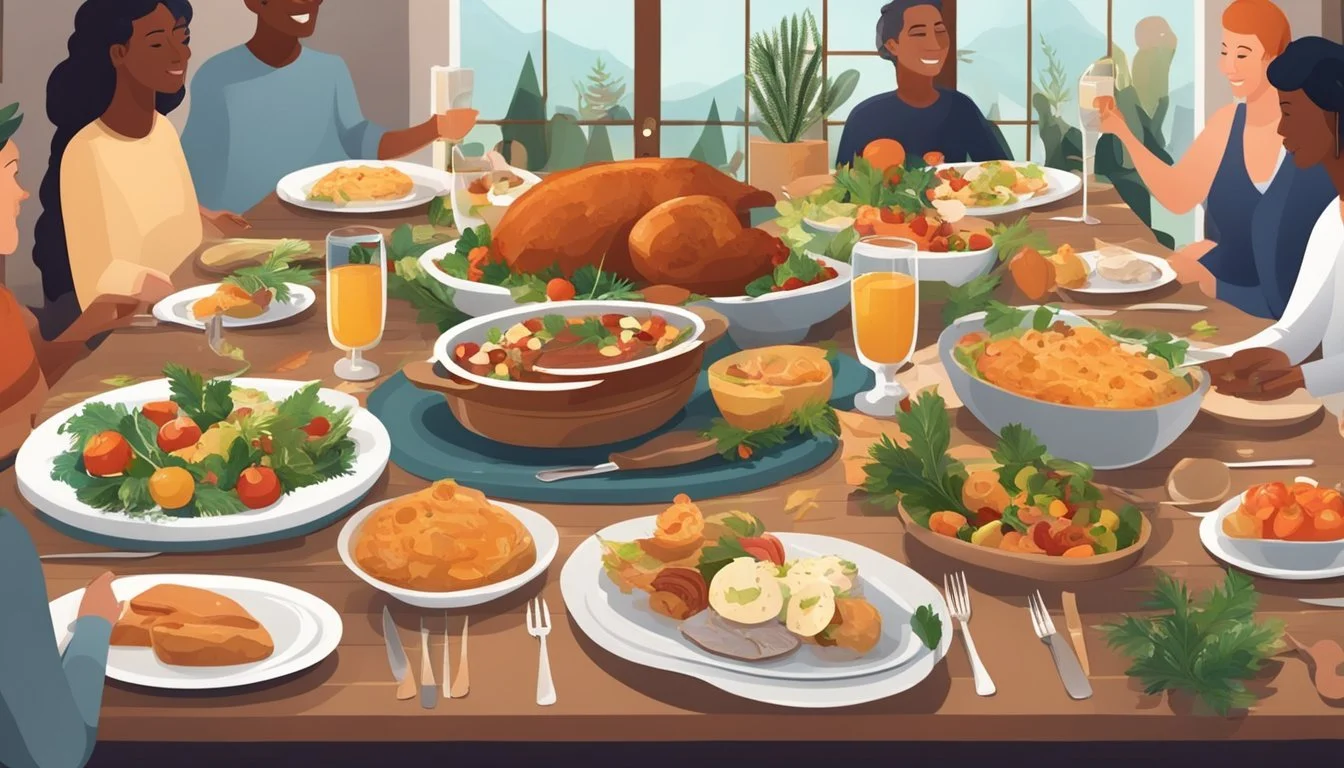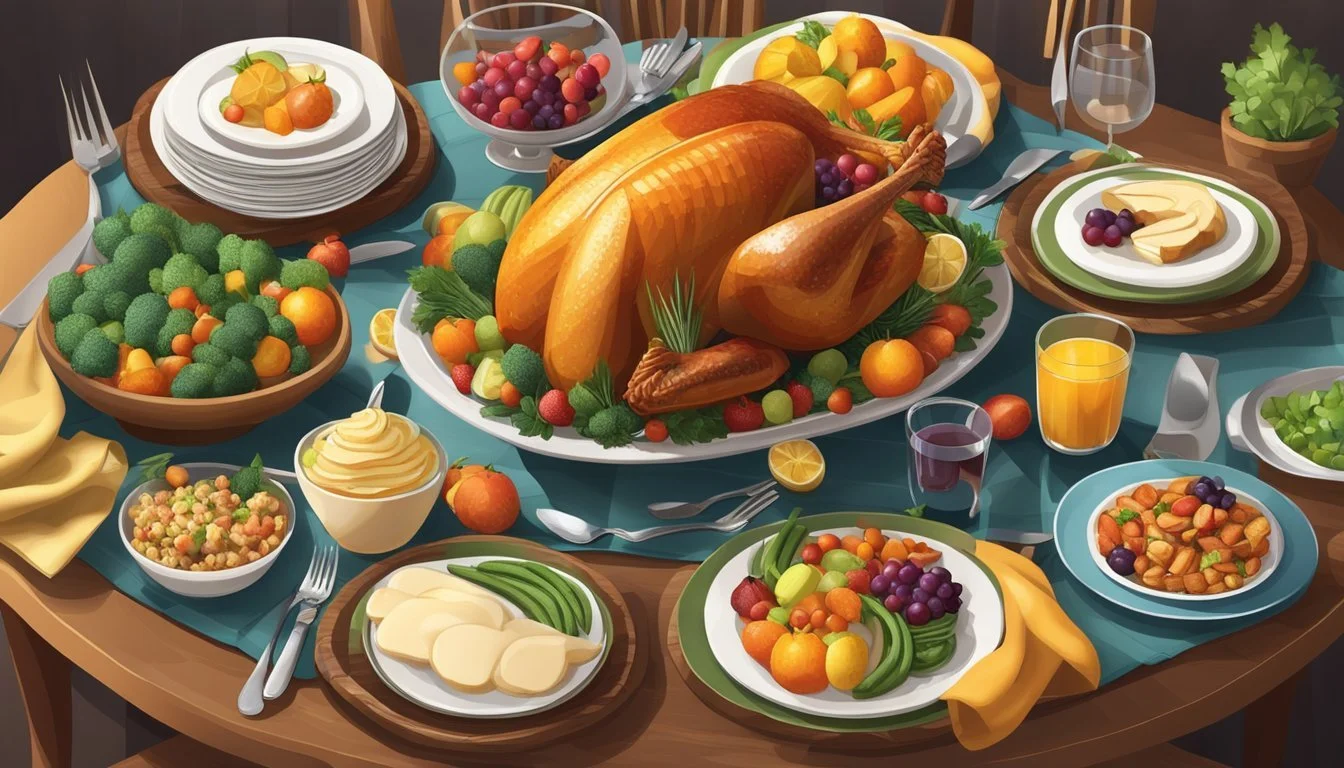How to Handle Holidays and Special Occasions on Paleo
Enjoying Festivities Without Compromise
Maintaining a paleo lifestyle during holidays and special occasions requires planning and thoughtfulness. Special events often center around food that may not align with the paleo philosophy of whole, unprocessed foods. However, it is entirely possible to navigate holiday feasts and celebrations without compromising on health or dietary principles. By setting clear goals and making informed choices, individuals can partake in the festivities while still adhering to their paleo commitments.
The key to successfully handling holidays on a paleo diet is preparation. This means identifying which dishes are paleo-friendly, and which ones can be modified to fit the dietary framework. It's also helpful to plan and bring one's own side dishes or desserts to gatherings. This ensures that there will be suitable options available. Moreover, focusing on the social aspects of these occasions rather than the food itself can help individuals stay on track.
Another aspect involves managing expectations, both one's own and those of friends and family members. It's important for individuals to communicate their dietary choices, if needed, to avoid unnecessary pressure or misunderstanding during these events. With a combination of clear communication, strategic planning, and a focus on the true purpose of the occasion—spending time with loved ones—a paleo lifestyle can be maintained without missing out on the joy and connection that holidays bring.
Understanding Paleo Fundamentals
When approaching the Paleo diet during special occasions, it is crucial to grasp its core principles and the nutritional advantages it offers. Clear understanding ensures individuals can navigate holiday festivities while adhering to Paleo-friendly choices.
Defining the Paleo Diet
The Paleo diet focuses on consuming foods that would have been available to our Paleolithic ancestors. This means that Paleo-friendly foods include lean meats, fish, vegetables, fruits, nuts, and seeds. It excludes processed foods, grains, dairy, and legumes, aiming to eliminate modern agricultural products that humans have not evolutionarily adapted to digest.
Health Benefits of Paleo
Adherents of the Paleo diet often report improvements in nutrition and overall health. Potential benefits include weight loss, better blood sugar regulation, increased energy levels, and reduced inflammation. These gains are attributed to the diet's emphasis on whole foods and the exclusion of processed and high-glycemic index items.
Paleo Diet Basics
To adhere to a Paleo lifestyle, one should focus on the following basics:
Whole foods: Opting for unprocessed and organic options when possible.
Lean proteins: Including ample portions of grass-fed meat, poultry, and seafood.
Fruits and vegetables: A diverse variety for fiber, vitamins, and minerals.
Healthy fats: Consuming nuts, seeds, and oils like olive and coconut oil.
Avoidance of non-Paleo foods: Steering clear of dairy, grains, processed sugars, and legumes.
By maintaining these guidelines, individuals can enjoy holiday feasts and special occasions while staying true to a Paleo way of eating.
Preparing for Holidays on Paleo
When approaching the holiday season on a Paleo diet, one's focus should be on meal planning, managing stress, and handling the social aspects of gatherings.
Planning Paleo-Friendly Meals
To ensure success in staying Paleo during holidays, one should start by crafting a menu that accommodates their dietary needs. This involves selecting recipes that utilize whole foods, such as vegetables, fruits, meats, and nuts. For Thanksgiving, a turkey dinner (What wine goes well with turkey dinner?) with a variety of vegetable sides fits the Paleo framework perfectly. When baking, one might opt for almond flour or coconut flour instead of traditional grain-based flours. Providing options like these ensures that festive meals remain both delicious and compliant with Paleo principles.
Thanksgiving Example:
Main Dish: Roasted turkey with fresh herbs.
Side Dishes: Steamed green beans, roasted root vegetables, and a salad with nuts and fruits.
Dessert: Pumpkin pie with an almond flour crust.
Overcoming Holiday Stress
Stress can be a considerable challenge during holiday times. To mitigate this, it's essential to practice self-care and maintain a routine that includes ample sleep, exercise, and relaxation techniques. Staying active with a walk or a quick workout session can help in managing stress levels. Additionally, ensuring adequate intake of nutrients like Vitamin D and Vitamin C can support immune health during colder months.
Stress-Reduction Strategies:
Physical Activity: Daily 30-minute walks or yoga sessions.
Sleep: Aim for 7-9 hours per night.
Nutrition: Increase intake of foods high in Vitamin D and C.
Navigating Social Gatherings
Attending a holiday party can present challenges for those adhering to a Paleo lifestyle. Communication is critical; one might consider informing the host of their dietary needs in advance or offering to bring a Paleo-friendly dish to share. For impromptu gatherings, having go-to Paleo snack options at hand can be a lifesaver. When dining at others' homes, it's beneficial to focus on the social aspect of the event and discreetly choose options that align with Paleo guidelines.
Party Tips:
Communication: Inform the host of your dietary preferences ahead of time.
Contribution: Offer to bring a dish that everyone can enjoy, ensuring you have something to eat.
Selection: Opt for meat, vegetable, and fruit options available at the event.
Paleo Holiday Recipes
Embracing a Paleo lifestyle during the holidays doesn't have to mean missing out on festive flavors. With the right recipes, those following a Paleo diet can enjoy delicious holiday meals (What wine goes well with holiday meals?) that cater to their dietary needs.
Festive Main Courses
Classic Roast Turkey: The centerpiece of many holiday tables is a succulent roast turkey. For the Paleo version, one should use fresh herbs and ghee for basting to keep the bird moist and flavorful, avoiding processed ingredients. Cooking the turkey in a preheated oven ensures an even roast.
Paleo Side Dishes
Roasted Vegetables: Toss carrots, brussels sprouts (how long do brussels sprouts last?), and sweet potatoes with olive oil, sea salt, and fresh rosemary. Cook in an oven set to a high temperature until they are nicely caramelized.
Cauliflower Mash: Steam cauliflower florets and blend with garlic, ghee, and nutritional yeast for a creamy side dish that mimics the texture and comfort of traditional mashed potatoes.
Desserts and Treats
Paleo Chocolate Chip Cookies: These treats can be made using almond flour, coconut sugar, and dark chocolate chips that are soy and dairy-free.
Spiced Desserts: Using cinnamon and ginger can infuse holiday cookies and cakes with the warm, nostalgic flavors typically associated with this time of year.
Holiday Appetizers
Pomegranate Guacamole: Pomegranate seeds add a pop of color and a burst of flavor to traditional guacamole, making it a festive holiday appetizer.
Dairy-Free Queso Dip: A smooth, dairy-free queso dip can be made with nutritional yeast and almond milk, perfect for dipping vegetables or Paleo-approved chips.
Practical Tips for a Paleo Holiday Season
With careful planning and smart choices, one can navigate the holiday season while adhering to a Paleo diet. These tips focus on ingredient substitutions, Paleo-friendly versions of favorite holiday dishes, and strategies for maintaining a commitment to Paleo principles.
Substituting Non-Paleo Ingredients
Substituting non-Paleo ingredients with Paleo-friendly alternatives is crucial. For instance:
Dairy: Replace dairy with coconut milk or almond milk in recipes.
Potato: Opt for mashed cauliflower as a substitute for mashed potatoes.
Salt: Use Himalayan pink salt or sea salt instead of table salt for more natural minerals.
Olive Oil: Choose extra virgin olive oil for cooking and salad dressings in place of vegetable or canola oils.
Paleo Options for Traditional Dishes
Creating Paleo versions of holiday favorites can keep the festive spirit alive:
Turkey: Prepare a herb-roasted turkey using olive oil and fresh herbs.
Side Dishes: Serve dishes like roasted Brussels sprouts with bacon, or sautéed green beans with slivered almonds.
Cranberries: Make a fresh cranberry sauce sweetened with honey or apple juice.
Staying True to Your Paleo Commitment
Staying true to a Paleo diet during the holidays requires determination:
During holiday gatherings, bring a Paleo dish to share, ensuring there's something you can enjoy.
Stay active by incorporating walks or family games to balance indulgence with physical activity.
Special Paleo Considerations for Major Holidays
When navigating major holiday feasts on a Paleo diet, one should prioritize whole foods and plan ahead to maintain dietary guidelines while enjoying the festive season.
Christmas and Paleo Eating
For Christmas dinner, individuals can focus on high-quality proteins like grass-fed beef or organic turkey as the centerpiece. They should opt for non-starchy vegetables as side dishes, such as Brussels sprouts and carrots, and replace traditional sugary cranberry sauce with a homemade version sweetened with fresh oranges or apple juice. Desserts can be crafted from almond flour and natural sweeteners to keep the Christmas spirit alive without straying from Paleo principles.
A Thanksgiving Paleo Feast
A Thanksgiving dinner offers ample opportunity to stay within Paleo boundaries. They can choose a naturally raised turkey as the star of their feast. Traditional stuffing can be reinvented using ingredients like nuts, seeds, and diced apples. Instead of processed gravy, they should use the turkey drippings with arrowroot powder for thickening. Lastly, pumpkin or sweet potato can be used in desserts, sweetened with pure maple syrup or honey.
Paleo-Friendly Hanukkah Celebration
For a Hanukkah celebration, one can substitute regular potato latkes with versions made from grated sweet potatoes (What wine goes well with sweet potatoes?) or turnips and fry them in avocado oil for a healthier alternative. When creating dishes that involve dairy, such as kugel, they should use nut-based 'cheeses' or creams. For the traditional brisket, one should ensure it's grass-fed and avoid sugar-laden sauces, opting instead for natural spices and herbs to enhance flavor.
Paleo Alternatives to Sugary Holiday Treats
The holiday season often brings with it a bounty of sugary treats that can be challenging for those on a paleo diet. However, with the right ingredients and recipes, one can enjoy delicious desserts and candies that align with paleo principles.
Healthy Paleo Sweets
Paleo Chocolate Chip Cookies: They can be made using almond flour, coconut oil, and dark chocolate chips that are at least 70% cacao to ensure minimal processing and sugar content. One can also opt for natural sweeteners like honey or pure maple syrup instead of refined sugars.
Dairy-Free, Gluten-Free Christmas Desserts: Alternatives such as a raw German chocolate pie use natural, wholesome ingredients like dates and nuts to replicate the richness without dairy or gluten. These desserts often incorporate winter's coziest ingredients like cinnamon and ginger to enhance flavor without relying on sugar.
For Paleo-friendly cakes and puddings:
Eggnog Tapioca Pudding: Utilizes ingredients like coconut milk and natural sweeteners.
Paleo Clementine Cake: A simple, citrus-infused treat often sweetened with honey.
Avoiding Candy Canes and Other Candies
Candy Canes: Traditional candy canes are off-limits on a paleo diet due to their high sugar and artificial coloring content. However, one can find or make alternatives using natural peppermint flavoring and coloring derived from fruit or vegetable juices.
Healthy Holiday Candy Recipes:
Dark Chocolate Bark can satisfy sweet tooth cravings—varieties may include mix-ins like cranberries, nuts, and a sprinkle of sea salt.
Homemade Paleo Candy: Such as peanut butter cups using unsweetened peanut butter and paleo-compliant chocolate can fill the void left by conventional candies.
By focusing on wholesome ingredients and creative replacements, it is entirely possible to celebrate holidays on a paleo diet without missing out on the joy of festive sweets.
Holidays on a Paleo Autoimmune Protocol (AIP)
Navigating the holiday season on the Paleo Autoimmune Protocol involves careful planning and a focus on health and nutrition. One can maintain their commitment to the AIP lifestyle during celebrations by understanding the protocol's facets and implementing strategic meal planning.
Understanding AIP on Paleo
The Paleo Autoimmune Protocol is a stringent version of the Paleo diet designed to reduce inflammation and aid those with autoimmune disorders. It eliminates potential inflammatory foods such as grains, legumes, nuts, seeds, nightshades, eggs, and dairy. AIP emphasizes nutrient-dense foods like vegetables (excluding nightshades), quality meats, and fermented foods to support immune system regulation and gut health.
AIP Holiday Meal Strategies
Holidays can be managed effectively on AIP by employing the following strategies:
Preparation: Advanced planning of AIP-compliant meals ensures one can partake in festivities without stress. This involves selecting recipes that substitute common holiday foods with AIP-friendly ingredients.
Communication: It's essential to communicate dietary restrictions to hosts to avoid potential issues. One may also consider hosting the meal themselves to have control over the menu options.
Sample AIP Holiday Meal:
AIP-Friendly Dish Ingredients AIP Stuffing AIP Biscuits, onions, and celery Pasture-Raised Turkey Herb-seasoned, pasture-raised turkey Seasonal Vegetables Roasted carrots and Brussels sprouts
Incorporating nutrient-rich ingredients is not just a healthy choice but can also lead to the creation of new food traditions that honor one's well-being.
Maintaining Paleo Nutrition During Festivities
During holiday celebrations and special occasions, it is crucial to focus on nutritional balance and choosing foods rich in nutrients to stay aligned with Paleo dietary guidelines.
Balancing Vitamins and Macronutrients
A Paleo diet during festivities should maintain a balance of vitamins and macronutrients to support overall health. An emphasis on Vitamin C is particularly important as it supports the immune system and is abundant in many fruits and veggies suitable for Paleo.
Vitamins: Ensure a variety of vegetables and fruits are on the menu. For example, bell peppers and berries are high in Vitamin C.
Protein: Quality meats and fish remain the staple of the Paleo diet, providing essential amino acids.
Fats: Avocados, nuts, and seeds offer healthy fats and can be included in meals or as snacks.
Carbohydrates: Opt for nutrient-dense, fibrous vegetables and fruits such as sweet potatoes and apples.
Choosing Nutrient-Dense Foods
One should prioritize nutrient-dense foods to maximize nutrition while adhering to a Paleo lifestyle during the holidays.
Vegetables: Go for a variety of colors to get a wide range of nutrients, such as green leafy vegetables for iron and sweet potatoes for beta-carotene.
Fruits: Select fruits that offer more than just sweetness, like oranges and kiwis, which are high in Vitamin C and fiber.
Italicize non-starchy vegetables and fruits to highlight their importance, and integrate them into festive meals in creative ways, such as using cauliflower as a substitute for traditional grain-based sides.
Cultural Traditions and Paleo Adaptations
When adapting holiday traditions to a Paleo lifestyle, it's important to focus on whole, unprocessed foods and to find creative ways to include these in festive meals. Here are ways to honor cultural practices while maintaining Paleo-friendly choices.
Integrating Paleo Into Holiday Traditions
One can modify holiday dishes to be Paleo-friendly by replacing grains, legumes, and dairy with whole food alternatives. For example, one might replace traditional stuffing with a version made from diced vegetables, fruits, and nuts. Mashed potatoes can be substituted with mashed cauliflower for a lower-carb option that fits neatly within Paleo guidelines. During Thanksgiving, replacing the bread-based stuffing with a mixture of sautéed onions, mushrooms, apples, and herbs can keep the spirit of the holiday alive.
For those who partake in the Whole30 program during the holidays, it's essential to plan ahead and make sure that all ingredients used in holiday dishes are compliant. Consequently, if one is preparing a Whole30-compliant dish, they would use ghee instead of butter, and natural sweeteners like dates in place of sugar.
Paleo-Friendly Festive Traditions
Families can create new traditions that are in line with Paleo principles by emphasizing activities that aren't food-centric, such as outdoor games and walks, or by introducing new Paleo-approved holiday dishes. Below are two examples of such adaptations:
Christmas:
Roasted Meat: A centerpiece of roasted meat such as turkey, beef, or lamb that is seasoned with herbs aligns with Paleo guidelines and maintains the festive feel.
Halloween:
Pumpkin Dishes: Carving pumpkins can still be a fun activity, and the insides can be used for Paleo-friendly recipes—like roasted pumpkin seeds or pumpkin soup.
By focusing on fresh, natural ingredients and the joy of togetherness, anyone can enjoy cultural celebrations while remaining true to their Paleo lifestyle.
Conclusion
Navigating special occasions while adhering to the paleo lifestyle is achievable with strategic planning and a positive mindset. That approach allows one to enjoy holiday experiences without compromising health goals. Here are some key takeaways:
Immune Support: Individuals should prioritize their immune system, especially during the holidays. This can ensure they are well to enjoy the festivities.
Physical Activity: Staying active is vital. Suggest group activities like walking or playing games to stay in line with paleo principles.
Stress Management: The holidays can induce stress, but one can mitigate this through realistic expectations and simplifying commitments.
Flexibility: Embracing minor deviations when necessary can be more beneficial than striving for 'Paleo perfection'. This allows for a more relaxed and joyous holiday season.
Mindful Choices: Opt for paleo-friendly alternatives when faced with traditional holiday dishes. This supports the paleo lifestyle while participating in the celebration.
Individuals should remember that the essence of the holiday season is connection and joy. The paleo lifestyle is not a restriction but a different way of celebrating that is in alignment with one's health objectives. They can reflect on their holiday recaps, looking back at how they successfully navigated the challenges, as a further motivation for maintaining their lifestyle choices throughout the year.







